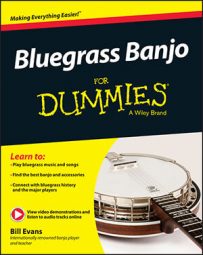From bluegrass banjo’s first‐generation masters to today’s genre‐busting stylists and master teachers, it’s worth spending time getting to know these important musicians and their music. You’ll become a better banjo player by opening your mind and ears to their amazing contributions.
Earl Scruggs (1924–2012)
Earl Scruggs was just 21 years old when the world first heard his revolutionary three‐finger picking technique in 1945. Since that time, Earl’s playing has come to define bluegrass banjo style. While others before him played the banjo using the thumb, index finger, and middle finger, Earl perfected this approach to create a vast landscape of techniques that not only redefined the musical potential of the instrument but set a standard for bluegrass banjo that is still observed today. He’s still the best!
All the other banjo players on this list ultimately base their own innovations on the foundation that Earl Scruggs laid many years ago.
Don Reno (1927–1984)
Down in South Carolina, Don Reno was developing his own three‐finger approach to playing the banjo at the same time Earl Scruggs was honing his skills up in North Carolina. At the height of his professional career in the 1950s and early 1960s, Don’s jazzy, guitar‐influenced banjo style introduced single‐string scales, chordal licks, and other sophisticated playing techniques that continue to inspire and influence today’s top players.
J. D. Crowe (1937– )
J. D. Crowe is the most influential bluegrass banjo player of the last four decades and is largely responsible for moving the banjo and bluegrass music as a whole into the modern era. Using Earl Scruggs as a starting point, J. D. incorporates folk, country, and early rock‐’n’‐roll influences to create a rhythmically precise, bluesy, and driving banjo style with some memorable classic licks.
Veronica “Roni” Stoneman (1938– )
Along with her siblings Patsy and Donna, Roni Stoneman opened doors for women in bluegrass and country music as a member of the Stoneman Family and later as a cast member of the popular television program Hee Haw. She was the first woman to play bluegrass‐style banjo on LP (American Banjo: Three‐Finger and Scruggs Style in 1957) and achieved crossover success with the Stoneman Family through their syndicated TV show. The group was awarded the Country Music Vocal Group of the Year award in 1967. Roni actively performs today.
Bill Keith (1939– )
Bill Keith is largely responsible for creating and popularizing the melodic style of playing the banjo, an alternative to the Scruggs technique that enables you to play scales using conventional roll‐based picking techniques. His dedication to music theory has inspired thousands of players to step outside their bluegrass comfort zones to embrace the banjo as an instrument that’s capable of playing all kinds of music. Bill is also the inventor of the Keith “D” tuning pegs, which allow you to precisely change a string’s pitch as a song is being played.
Tony Trischka (1949– )
Tony Trischka is the modern banjo player’s banjo player. He’s in his element whether he’s playing a hard‐driving traditional Scruggs‐oriented original composition or exploring deep improvisational space at the outer edges of the banjo solar system. Tony is one of the banjo’s most gifted composers, and he’s a stellar instructor and author as well. His boundless curiosity and enthusiastic sense of exploration have influenced all banjo players in his wake.
Murphy Henry (1952– )
Known equally for her writing, teaching, and playing, Murphy is the author of the classic study Pretty Good for a Girl: Women in Bluegrass, and is the co‐creator of the Murphy Method, a way of teaching that has helped thousands of adult learners to play bluegrass banjo without using tablature. She is a tireless spokesperson for women in bluegrass and a rock‐solid, hard‐driving Scruggs banjo stylist who is now hosting women’s banjo camps with daughter Casey in northern Virginia.
Béla Fleck (1958– )
Béla Fleck continues to break down musical barriers and establish new connections with every project he undertakes. The most celebrated banjo player in the world today, Béla has expanded our idea of what’s possible on the banjo by making the instrument right at home in the jazz, classical, and rock worlds. In the process, he has inspired thousands to take up the instrument.
None of this would have happened if Béla hadn’t brought an awe‐inspiring technical facility and stunning musicality to all that he plays.
Alison Brown (1962– )
Alison Brown is the consummate modern bluegrass banjo stylist. Her original music combines Irish, folk, Latin, and jazz influences performed with warmth and lyricism. Alison also certainly knows her bluegrass, as her recent recording, The Company You Keep, proves. She also owns her own record label, Compass Records, which has become an important player in the modern acoustic music industry.
Jens Kruger (1962– )
The future of bluegrass banjo goes international with the phenomenal Swiss musician Jens Kruger. Performing with his brother Uwe and bassist Joel Landsberg as the Kruger Brothers, Jens’s musicality and emotional expression have connected strongly with audiences all over the world. Jens combines complete technical mastery with a strong musicality to play banjo music that both moves and amazes, which can be a rare thing these days!
Kristin Scott Benson (1976– )
A four‐time International Bluegrass Music Association Banjo Player of the Year award winner (2008–2011), Kristin is one of today’s top mainstream bluegrass banjo masters. One of the first female instrumentalists to be featured in nationally touring bands, these days Kristin can be heard with bluegrass powerhouses the Grasscals.
Noam Pikelny (1981– )
Noam gained national attention as a member of the Punch Brothers, the band led by mandolin player extraordinaire Chris Thile, but you’ll also find him out on the road leading his own ensembles and sharing stages with fiddler Stuart Duncan and vocalist Aiofe O’Donovan. Noam reflects the taste and sensibility of a new generation of banjo players who naturally look more to Béla Fleck, Tony Trischka, and Radiohead for inspiration than to Earl Scruggs or Don Reno.

